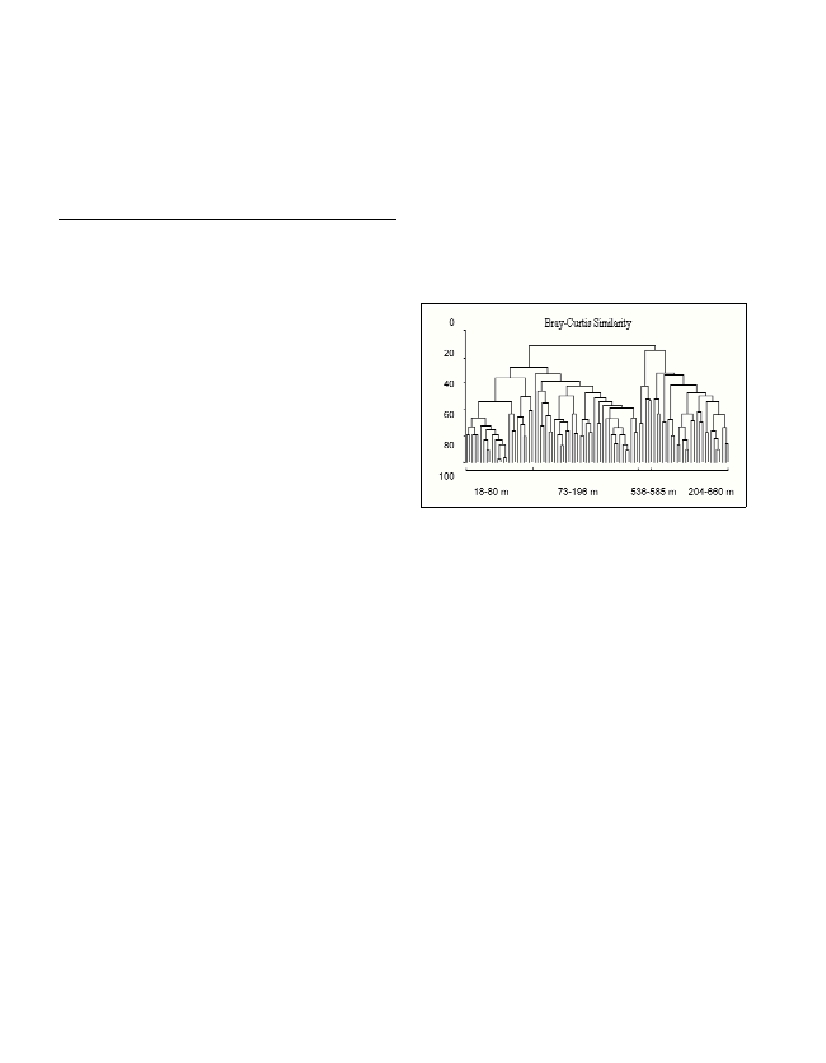CEPHALOPODS ASSEMBLAGES FROM THE SOUTHERN TYRRHENIAN SEA
Daniela Giordano
1
*, Teresa Bottari
1
, Barbara Busalacchi
1
, Paola Rinelli
1
, Silvestro Greco
2
1
IAMC – CNR, Messina, Italy
2
ICRAM, Roma, Italy
Abstract
The Teuthofauna assemblages of the Southern Tyrrhenian Sea were studied utilising data derived from five International Mediterranean
bottom trawl surveys. A total of 25 cephalopod species were found between 18 and 652 m depth. The assemblages were analysed with
Bray-Curtis similarity index. Four main groups were defined: inshore, shelf, slope and midslope. Allotheuthis mediawas the dominant
species inshore, Illex coindetiion the shelf, Todaropsis eblanaeon the slope, and Todarodes sagittatusfor the last group.
Key words: Cephalopods, Faunal assemblages, Mediterranean Sea
Rapp. Comm. int. Mer Médit., 37,2004
365
Introduction
The geographic and bathymetric distributions of demersal
cephalopods have been studied in great detail in the Mediterranean
(1,2,3,4), since many species are of commercial interest. The present
work analyses the structure of the cephalopod assemblages in order to
provide information concerning their distribution inshore, on shelf,
slope and midslope in the Southern Tyrrhenian Sea.
Material and methods
The material was collected at depths ranging from18 to 652 m,
between 1995 and 1999, in the Southern part of the Tyrrhenian Sea
(central Mediterranean), between Suvero Cape (Calabria) and S. Vito
Cape (Sicily), as part of the MEDITS project funded by the European
Community.
A fishing vessel equipped with an experimental trawl net with 20
cm stretched mesh size in the cod-end, and 2-2.5 m of vertical
opening was used. A total of 139 hauls were carried out, randomly
allocated into five bathymetric strata (5). All cephalopods were
identified and counted on board. A multivariate approach, on the basis
of the calculation of a triangular similarity matrix (group-average
linkage), by depth, year and abundance (number of specimens/hour),
according to Bray-Curtis with the relative dendrogram was elaborated
(6). The abundance values were also analysed by means of univariate
indices, in relation to the four assemblages evidenced by cluster
analysis: total number of taxa (S), total number of individuals (N),
richness of Margalef (d), Shannon-Wiever diversity (H’) and Pielou’s
evenness (J) indices
Results and discussion
A total of 25 cephalopod species were collected, belonging to three
orders and eight families. The following species - Onychoteuthis
banksii,Ancistroteuthis lichtensteinii andAbralia veranyi -were
caught only once. Sepia officinalis was confined to shallow waters,
less than 68 m deep. Half of the species had a wide bathymetric range
that included the shelf and the beginning of the slope. The widest
bathymetric distribution was that of Eledone cirrhosa(72-584 m),
Scaeurgus unicirrhus(38-549 m), Todaropsis eblanae(61-613 m) and
Pteroctopus tetracirrhus(118-633 m). Alloteuthis subulata, Octopus
vulgarisand Eledone moschatawere found only on the continental
shelf; whereas Octopus salutiiand Rossia macrosomawere collected
only in depths greater than 200 m. Histioteuthis bonnelli was found
exclusively in the deepest zone.
The dendrogram (Fig. 1) showed four clusters: I, inshore (<100 m);
II, shelf (80-200m); III, slope (200-600m); IV, midslope (360-580
m). The inshore group was characterized by Allotheutis mediaand
Loligo vulgaris. In the shelf group, Illex coindetiiand Allotheutis
mediaprevailed, followed by Sepia orbignyana, Sepia elegansand
Scaeurgus unicirrhus. The slope group was characterized by
Todaropsis eblanae. In the midslope, consisting of few hauls,
Todarodessagittatuswas the prevalent species.
Analysing the univariate indices, elaborated for the four groups, the
highest biodiversity was observed in the shelf. In this zone, the highest
values of Margalef and Shannon Weaver indices were recorded as
well as the highest number of species and individuals. The highest
values of H’can be explained by the relative homogeneity in
abundances of the most frequent species. However a trend was
observed according to the depth as evidenced also by the cumulative
abundance curve, in which the shelf group showed the highest
biodiversity and the middle-slope the lowest. In this last group both
“d” and “H’” values recorded the lowest values (0.973 and 1.063
respectively). Finally the Evenness (J’) values ranged from 0.616 to
0.661. The higher values era recorded for the last cluster. Also in the
second cluster his values is quite high.
The 25 cephalopod species recorded in this study account for
42.4% of the species known from the Mediterranean (7).
Fig. 1. Dendrogram showing similarities between hauls for the five sur-
veys. Mean depth of each haul is presented.
References
1-Sanchez P., Belcari P., and Sartor P., 1998. Composition and spatial
distribution of cephalopods in two north-western Mediterranean areas.
S.Afr. J. mar. Sci., 20: 17-24.
2-Ruby J.J., and Knudsen J., 1972. Cephalopoda from the Eastern
Mediterranean. Israel J. Zool., 21: 83-97.
3-Jereb P., and Ragonese S., 1994. The Mediterranean teuthofauna:
Towards a biogeographical coverage by regional census. II. Strait of Sicily.
Boll. Malacologico,30 (5-9): 161-172.
4-González M., and Sánchez P., 2002. Cephalopod assemblages caught
by trawling along the Iberian Peninsula Mediterranean coast. Sci. Mar., 66
(Suppl. 2): 199-208.
5-Bertrand J.A., Gil de Sola L., Papaconstantinou C., Relini G., and
Souplet A., 2002. An international bottom trawl in the Mediterranean: the
MEDITS programme. 1995 ICES Annual Science Conference, CM
1997/y:03: 16 p.
6-Clarke K.R., and Warwick R.M., 1994. Change in marine
communities: an approach to statistical analysis and interpretation.
Plymouth: Plymouth Marine Laboratory, 144 p.
7-Mangold K., and Bolesky S., 1988. Mediterranean Cephalopod Fauna.
In: M.R. Clarke and E.R. Trueman (eds.), Etology and Neontology of
Cephalopods, The Mollusca, 12: 315-330. San Diego, Academic Press.

